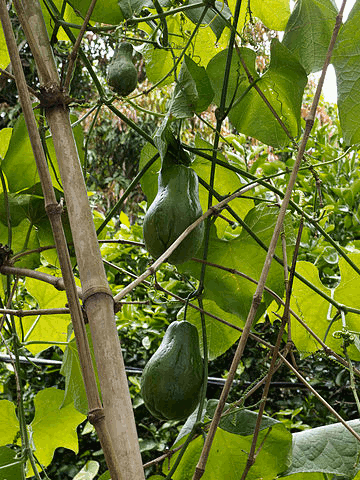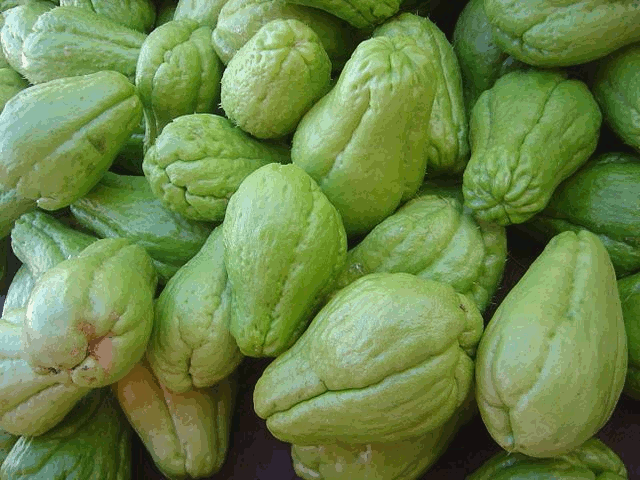Chayote
 Common Names: Chayote, mirliton, choko
Common Names: Chayote, mirliton, choko
Scientific Name: Sechium edule
Climate: Warm
Plant Description: The chayote is a climbing plant, from the same family as cucumber, melon and watermelon. It has robust stems and grows up to ten meters in height. The leaves are large in size, about ten centimeters.
It has two types of flowers. The yellow ones are male and the green ones are female. The fruit they produce looks like a large pear. It has a green green color and is whiter inside. One variety has prickly skin. It has just one seed in the center that comes covered in fibers.
Cultivation: Being from tropical lands, the chayote needs a lot of humidity. It grows best in temperatures of 13 - 21 °C but can withstand higher temperatures. It needs full sunlight and loose, well-drained soils with lots of organic matter. In very sandy or clayey soils, production is lower.
The seeds can be germinated in a seedbed and when they have a sprout of about 20 cm, they are transplanted into the ground. As it is a climbing plant, it needs a support structure to grow or it can also be planted under trees. For this reason, it is a good option to grow in the edible forests.
It is better to plant it in winter. Weekly abundant watering is sufficient but it is necessary to water more frequently when temperatures rise. It takes about five months to flower. When the flowers are fertilized, it takes about 25 days for the fruit to mature and then it is ready to harvest. It stays fresh for ten to 15 days if kept dry.
 Uses: Chayote is rich in fiber and has very little fat. It contains carotenes, vitamin C and has antioxidant properties. It also has potassium that helps eliminate toxins from the body.
Uses: Chayote is rich in fiber and has very little fat. It contains carotenes, vitamin C and has antioxidant properties. It also has potassium that helps eliminate toxins from the body.
Chayote is normally eaten boiled or steamed. It is used in broths, soups and stews along with other vegetables.
Pests and Diseases: Well-drained soil can prevent fungi that can affect chayote.
The whitefly and the red spider are the main pests that attack the plant. Tomato, calendula, or other aromatic plants planted together with chayote work as a repellent for whiteflies. Sticky yellow traps are another very effective and eco-friendly way to control the whitefly. A dilution of garlic applied to the leaves keeps away the whitefly and also the red spider. It is important to remove and burn leaves that are infected.
References:
https://www.flores.ninja/el-chayote/
https://www.agrohuerto.com/como-cultivar-chayote-en-el-huerto-ecologico/
https://www.thermorecetas.com/articulos/el-chayote-y-sus-mil-y-un-nombres/
https://www.agrohuerto.com/control-de-plagas-y-enfermedades-en-huertos-ecologicos/
En español: Chayote
